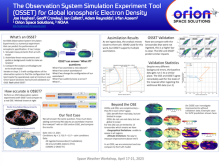The Observation System Simulation Experiment Tool (OSSET) for Global Ionospheric Electron Density
Joseph
Hughes
Orion Space Solutions
Poster
Decision makers are often tasked with choosing how many sensors to deploy, of what types, and in what locations to meet a given operational or scientific outcome. An Observing System Simulation Experiment (OSSE) is a numerical experiment which can provide critical decision support to these complex and expensive choices. There are three simulation steps in an OSSE:
(1) An observation system consisting of any combination of instruments such as ionosondes, GPS ground stations, satellite-based RO is specified, and the measurements are simulated using the truth model which contains the electron density at every location and time.
(2) These simulated measurements are provided to an assimilator which uses them to update a background model and create an analysis.
(3) The analysis and the background model are compared to the truth model. The degree to which the analysis improves relative to the background indicates the value of those measurements. This process can be repeated for multiple combinations of instruments to compare the relative impact of different data sets. The impact of a given sensor or group of sensors can be assessed, and the value of that impact can be compared with the cost of acquiring these datasets to estimate the “bang for the buck” in terms of improving ionospheric specification.
Orion Space Solutions has developed the OSSE Tool (OSSET) which is a software system used to perform ionospheric OSSEs. To our knowledge, it is the first such tool of its kind. This presentation has two parts. First, we describe OSSET's basic operation and what data sets it can simulate. Second, we compare OSSET's predictions of the impact of adding Radio Occultation TEC data to the real impact of adding RO data.
(1) An observation system consisting of any combination of instruments such as ionosondes, GPS ground stations, satellite-based RO is specified, and the measurements are simulated using the truth model which contains the electron density at every location and time.
(2) These simulated measurements are provided to an assimilator which uses them to update a background model and create an analysis.
(3) The analysis and the background model are compared to the truth model. The degree to which the analysis improves relative to the background indicates the value of those measurements. This process can be repeated for multiple combinations of instruments to compare the relative impact of different data sets. The impact of a given sensor or group of sensors can be assessed, and the value of that impact can be compared with the cost of acquiring these datasets to estimate the “bang for the buck” in terms of improving ionospheric specification.
Orion Space Solutions has developed the OSSE Tool (OSSET) which is a software system used to perform ionospheric OSSEs. To our knowledge, it is the first such tool of its kind. This presentation has two parts. First, we describe OSSET's basic operation and what data sets it can simulate. Second, we compare OSSET's predictions of the impact of adding Radio Occultation TEC data to the real impact of adding RO data.

Poster PDF
Poster category
Ionosphere and Thermosphere Research and Applications
Meeting homepage